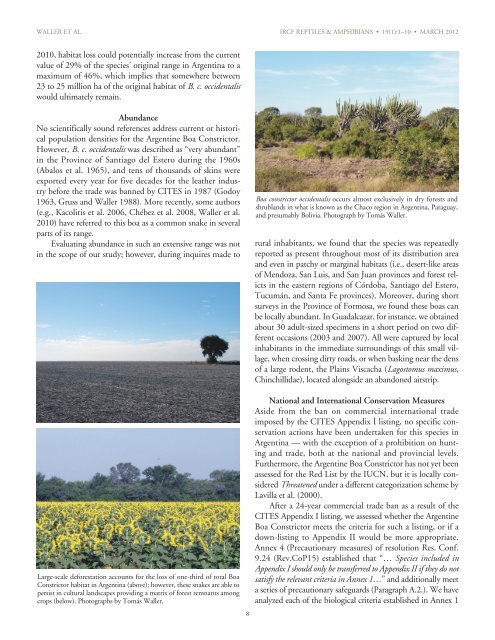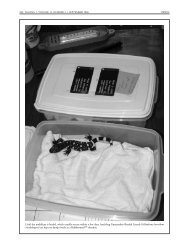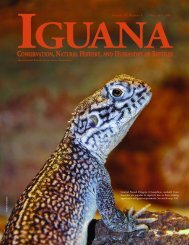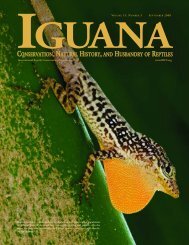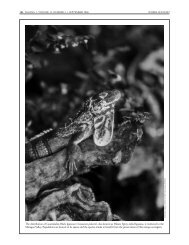Boa constrictor occidentalis - International Reptile Conservation ...
Boa constrictor occidentalis - International Reptile Conservation ...
Boa constrictor occidentalis - International Reptile Conservation ...
Create successful ePaper yourself
Turn your PDF publications into a flip-book with our unique Google optimized e-Paper software.
WALLER ET AL. IRCF REPTILES & AMPHIBIANS • 19(1):1–10 • MARCH 2012<br />
2010, habitat loss could potentially increase from the current<br />
value of 29% of the species’ original range in Argentina to a<br />
maximum of 46%, which implies that somewhere between<br />
23 to 25 million ha of the original habitat of B. c. <strong>occidentalis</strong><br />
would ultimately remain.<br />
Abundance<br />
No scientifically sound references address current or historical<br />
population densities for the Argentine <strong>Boa</strong> Constrictor.<br />
However, B. c. <strong>occidentalis</strong> was described as “very abundant”<br />
in the Province of Santiago del Estero during the 1960s<br />
(Abalos et al. 1965), and tens of thousands of skins were<br />
exported every year for five decades for the leather industry<br />
before the trade was banned by CITES in 1987 (Godoy<br />
1963, Gruss and Waller 1988). More recently, some authors<br />
(e.g., Kacoliris et al. 2006, Chébez et al. 2008, Waller et al.<br />
2010) have referred to this boa as a common snake in several<br />
parts of its range.<br />
Evaluating abundance in such an extensive range was not<br />
in the scope of our study; however, during inquires made to<br />
Large-scale deforestation accounts for the loss of one-third of total <strong>Boa</strong><br />
Constrictor habitat in Argentina (above); however, these snakes are able to<br />
persist in cultural landscapes providing a matrix of forest remnants among<br />
crops (below). Photographs by Tomás Waller.<br />
8<br />
<strong>Boa</strong> <strong>constrictor</strong> <strong>occidentalis</strong> occurs almost exclusively in dry forests and<br />
shrublands in what is known as the Chaco region in Argentina, Paraguay,<br />
and presumably Bolivia. Photograph by Tomás Waller.<br />
rural inhabitants, we found that the species was repeatedly<br />
reported as present throughout most of its distribution area<br />
and even in patchy or marginal habitats (i.e., desert-like areas<br />
of Mendoza, San Luis, and San Juan provinces and forest relicts<br />
in the eastern regions of Córdoba, Santiago del Estero,<br />
Tucumán, and Santa Fe provinces). Moreover, during short<br />
surveys in the Province of Formosa, we found these boas can<br />
be locally abundant. In Guadalcazar, for instance, we obtained<br />
about 30 adult-sized specimens in a short period on two different<br />
occasions (2003 and 2007). All were captured by local<br />
inhabitants in the immediate surroundings of this small village,<br />
when crossing dirty roads, or when basking near the dens<br />
of a large rodent, the Plains Viscacha (Lagostomus maximus,<br />
Chinchillidae), located alongside an abandoned airstrip.<br />
National and <strong>International</strong> <strong>Conservation</strong> Measures<br />
Aside from the ban on commercial international trade<br />
imposed by the CITES Appendix I listing, no specific conservation<br />
actions have been undertaken for this species in<br />
Argentina — with the exception of a prohibition on hunting<br />
and trade, both at the national and provincial levels.<br />
Furthermore, the Argentine <strong>Boa</strong> Constrictor has not yet been<br />
assessed for the Red List by the IUCN, but it is locally considered<br />
Threatened under a different categorization scheme by<br />
Lavilla et al. (2000).<br />
After a 24-year commercial trade ban as a result of the<br />
CITES Appendix I listing, we assessed whether the Argentine<br />
<strong>Boa</strong> Constrictor meets the criteria for such a listing, or if a<br />
down-listing to Appendix II would be more appropriate.<br />
Annex 4 (Precautionary measures) of resolution Res. Conf.<br />
9.24 (Rev.CoP15) established that “… Species included in<br />
Appendix I should only be transferred to Appendix II if they do not<br />
satisfy the relevant criteria in Annex 1…” and additionally meet<br />
a series of precautionary safeguards (Paragraph A.2.). We have<br />
analyzed each of the biological criteria established in Annex 1


